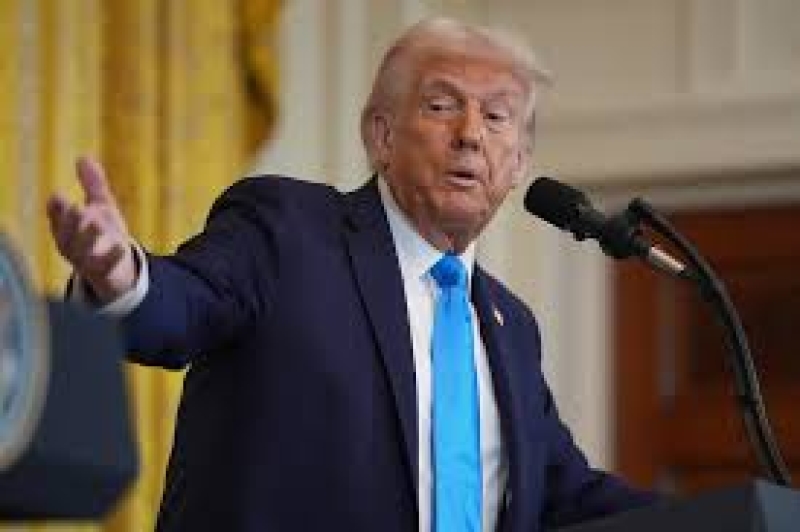- CA Yunus pays homage to Liberation War martyrs on Victory Day |
- Bangladesh capital market extends losing streak for second day |
- Bangladesh celebrates Victory Day Tuesday |
- 'Different govts presented history based on their own ideologies': JU VC |
Trump Aims to Reshape Asia’s Energy Landscape with US LNG

When President Donald Trump met with Japan’s Prime Minister Shigeru Ishiba earlier this month, discussions quickly turned to a decades-old plan: harnessing Alaskan natural gas to supply U.S. allies in Asia. The ambitious proposal envisions transforming Asia's energy supply by connecting the region with U.S. resources, particularly liquefied natural gas (LNG), shifting away from dependence on the Middle East.
Trump and his energy advisor, Doug Burgum, positioned the project as an opportunity for Japan to replace shipments from the Middle East and address the growing trade imbalance with the U.S., according to two officials familiar with the meeting. With both nations eager to avoid tensions over tariffs, Ishiba voiced cautious optimism about participating in the $44 billion project, despite lingering doubts about its feasibility.
While Trump continued to highlight the potential benefits of the Alaska LNG project in his public statements, Ishiba refrained from commenting, and the official readout of the talks made no mention of the issue.
Interviews with a dozen current and former U.S. and Asian officials have shed light on how the Trump administration is working to redefine economic relationships with East Asia by fostering closer energy ties. At the heart of this strategy is increased investment in U.S. fossil fuels, particularly LNG, in an effort to reduce Asian reliance on Russian and Middle Eastern sources while further isolating China and Russia in the energy sphere.
Japan’s involvement in this strategy is crucial. As the world's second-largest LNG importer and a key player in global energy markets, Japan could help the U.S. expand its gas exports to Southeast Asia. This would not only boost the U.S. economy but also create a robust network of energy dependence on Washington, reshaping global energy alliances.
“If the Trump administration has its way, LNG would flow in massive quantities from the U.S. to Japan and South Korea, and from there, further into Southeast Asia,” said Kenneth Weinstein, Japan Chair at the Hudson Institute. “This could effectively redraw the map of global energy dependence, shifting it toward the U.S.”
In a joint statement on Saturday with U.S. Secretary of State Marco Rubio, Japan and South Korea agreed to strengthen energy security by tapping into America’s "affordable and reliable" energy sources, particularly LNG. However, the statement made no mention of the Alaska project.
Brian Hughes, White House National Security Spokesman, told Reuters, “The U.S. produces some of the cleanest LNG in the world, and we believe Japan can play a larger role in purchasing America’s abundant oil and gas.”
Japan's Ministry of Foreign Affairs declined to comment on the details of the Ishiba-Trump meeting, but Japan’s trade minister is scheduled to visit Washington next month to discuss potential exemptions from Trump’s tariffs and explore options for purchasing more U.S. LNG.
The Sales Pitch
The plan to build an 800-mile pipeline connecting Alaska’s North Slope to an export terminal on the Pacific Coast has faced delays due to cost and challenging terrain. However, the Trump administration is hopeful about overcoming these hurdles and gaining international support for the project.
During the February 7 meeting, U.S. officials pressed Japan to consider infrastructure investments in Alaska LNG and long-term purchase agreements. They highlighted the strategic advantages of the project, including its proximity to Japan compared to Middle Eastern sources and the avoidance of critical choke points like the Straits of Hormuz and the South China Sea.
Alaska Senator Dan Sullivan, who was briefed on the talks, emphasized the strategic significance of the project: “Having a president who is so forceful and dedicated to this project surely made an impression on the Japanese.”
The Trump administration is courting investment from companies like Inpex, a major Tokyo-listed oil and gas firm partly owned by the Japanese government. Inpex, which has yet to be involved in the Alaska project, declined to comment on the discussions.
Currently, Japan imports about 10% of its LNG from the U.S., a figure that is expected to grow as existing contracts with Russia and the Middle East expire. Over the next decade, U.S. LNG could account for as much as 20% of Japan’s total imports, according to Hiroshi Hashimoto, senior analyst at the Institute of Energy Economics, Japan.
Although U.S. LNG currently flows to Japan via the Gulf of Mexico, a more direct route from the U.S. West Coast would provide a more efficient path for U.S. gas. Sempra’s Costa Azul project in Mexico, set to begin operations next year, will further facilitate this flow.
Energy Security Bonds
Beyond Japan, other Asian nations are also considering increased imports of U.S. LNG as trade tariffs loom. Indian Prime Minister Narendra Modi pledged to bolster gas purchases in his meeting with Trump this month, and Taiwan, the democratically governed island claimed by China, is exploring more U.S. energy imports as a way to fortify its energy security in the face of growing regional tensions.
As U.S. energy exports increase, the administration envisions strengthening security bonds with its Asian allies. “By contracting for U.S. LNG, countries like Taiwan and South Korea are effectively securing a guarantee of U.S. support in times of conflict,” said Landon Derentz, a former senior U.S. energy official during Trump’s first term.
South Korea is also weighing investments in Alaskan LNG, with officials exploring ways to enhance energy security while seeking concessions on other trade issues. Bill Hagerty, U.S. Senator for Tennessee and former ambassador to Japan, sees the potential for Japan to become the key hub for distributing U.S. LNG throughout Asia.
“Whether the gas is from Alaska, Louisiana, or Texas, America and Japan can create a new framework for energy security that benefits both our economies and strengthens our national security,” Hagerty said.

